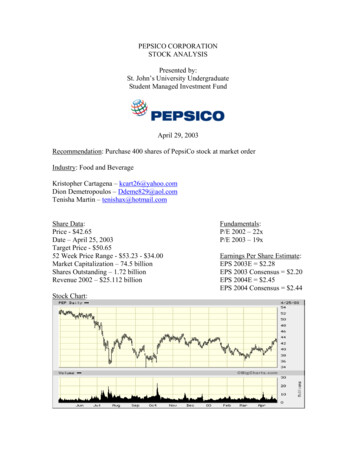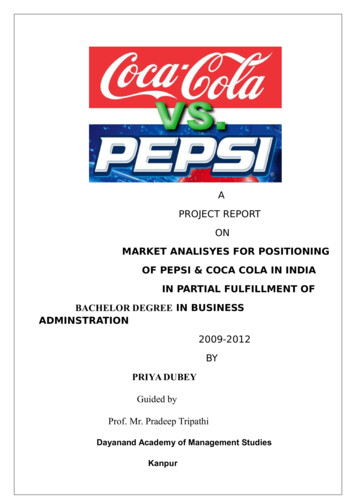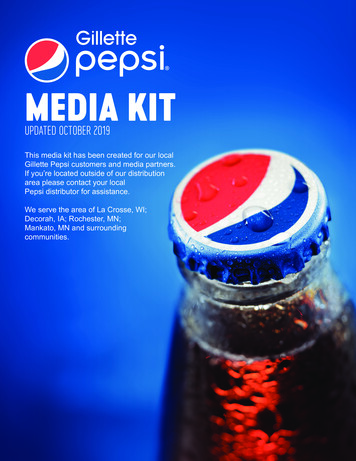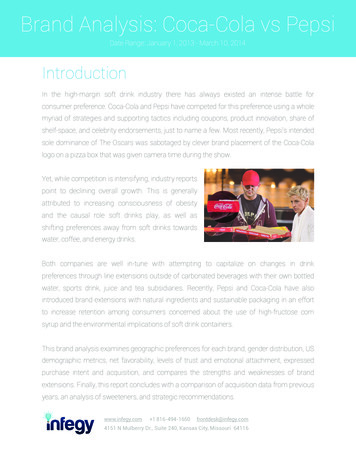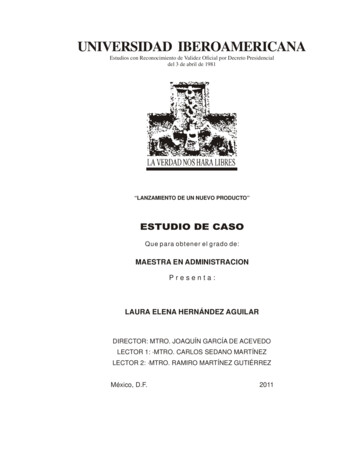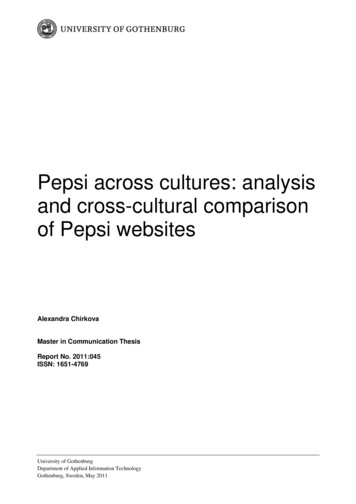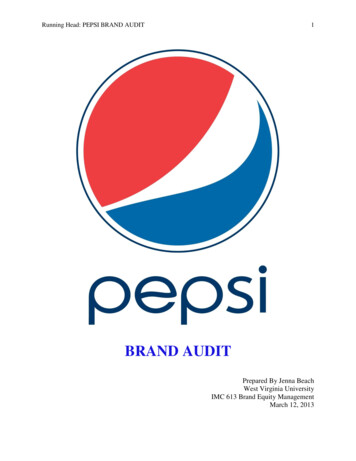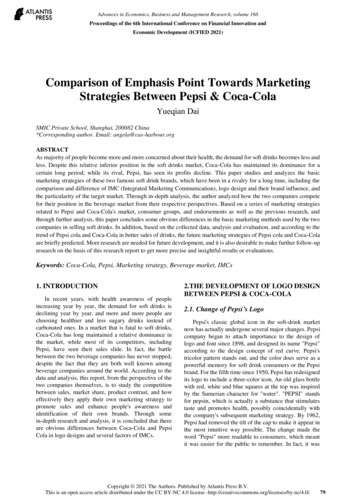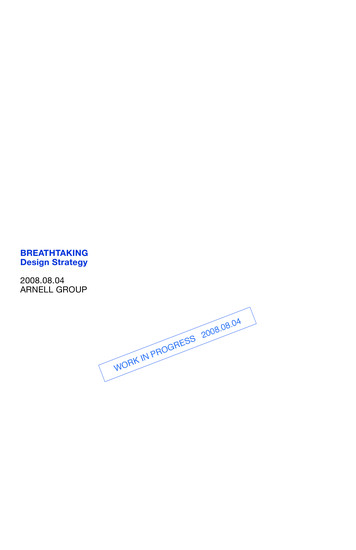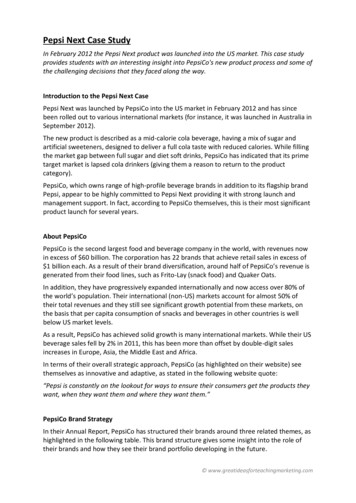
Transcription
Pepsi Next Case StudyIn February 2012 the Pepsi Next product was launched into the US market. This case studyprovides students with an interesting insight into PepsiCo's new product process and some ofthe challenging decisions that they faced along the way.Introduction to the Pepsi Next CasePepsi Next was launched by PepsiCo into the US market in February 2012 and has sincebeen rolled out to various international markets (for instance, it was launched in Australia inSeptember 2012).The new product is described as a mid-calorie cola beverage, having a mix of sugar andartificial sweeteners, designed to deliver a full cola taste with reduced calories. While fillingthe market gap between full sugar and diet soft drinks, PepsiCo has indicated that its primetarget market is lapsed cola drinkers (giving them a reason to return to the productcategory).PepsiCo, which owns range of high-profile beverage brands in addition to its flagship brandPepsi, appear to be highly committed to Pepsi Next providing it with strong launch andmanagement support. In fact, according to PepsiCo themselves, this is their most significantproduct launch for several years.About PepsiCoPepsiCo is the second largest food and beverage company in the world, with revenues nowin excess of 60 billion. The corporation has 22 brands that achieve retail sales in excess of 1 billion each. As a result of their brand diversification, around half of PepsiCo’s revenue isgenerated from their food lines, such as Frito-Lay (snack food) and Quaker Oats.In addition, they have progressively expanded internationally and now access over 80% ofthe world’s population. Their international (non-US) markets account for almost 50% oftheir total revenues and they still see significant growth potential from these markets, onthe basis that per capita consumption of snacks and beverages in other countries is wellbelow US market levels.As a result, PepsiCo has achieved solid growth is many international markets. While their USbeverage sales fell by 2% in 2011, this has been more than offset by double-digit salesincreases in Europe, Asia, the Middle East and Africa.In terms of their overall strategic approach, PepsiCo (as highlighted on their website) seethemselves as innovative and adaptive, as stated in the following website quote:“Pepsi is constantly on the lookout for ways to ensure their consumers get the products theywant, when they want them and where they want them.”PepsiCo Brand StrategyIn their Annual Report, PepsiCo has structured their brands around three related themes, ashighlighted in the following table. This brand structure gives some insight into the role oftheir brands and how they see their brand portfolio developing in the future. www.greatideasforteachingmarketing.com
Emphasis of BrandKey BrandsFun-for-youPepsi, Mountain Dew, 7-Up, Lays, Doritos, Cheetos, RedRockBetter-for-youPepsi Max, Diet Pepsi, Lays (oven baked), Quaker barsGood-for-youTropicana, Quaker Oats, Gatorade, Nut Harvest(Note: The various terms, ‘Fun-for-you’ and so on are PepsiCo’s terminology)As you can see from PepsiCo’s classification of their brands, it appears that the firm has thedual goals of supporting and leveraging its existing ‘fun’ brands, while moving towards abroader range of healthier offerings. While this second goal may appear to be mainlyrelated to improving their corporate image, it does have commercial intent, as explained onthe PepsiCo website: “Because a healthier future for all people and our planet means a moresuccessful future for PepsiCo.”To help implement this corporate goal, across their various brands, PepsiCo has focused onproviding a wider range of healthier choices, introducing more natural ingredients, reducingfat content, reducing the environmental impact of their packaging, and so on.Recent Product InnovationsPepsiCo has a history of developing and launching a number of mid-calorie beverages andPepsi Next is by no means their first attempt with this style of product. In addition to variousPepsi variations (described in the ‘Before Pepsi Next’ section below), they have had somerecent success with reduced calorie versions within their Tropicana and Gatorade brands.One very successful mid-calorie product initiate is Trop50, which was launched in 2010.Trop50, as implied by its name, is a version of Tropicana with 50% less sugar and calories.This new product was ranked as the 6th most successful new food/beverage product in itslaunch year with retail sales in excess of 70 million. Its initial success has continued overthe last two years, with the Trop50 product line now generating over 150 million in sales.And even more successful was Pepsi’s launch of Gatorade G2 in 2007. (Note: Pepsi acquiredthe Gatorade brand with their purchase of the Quaker Company in 2001.) This low-calorieversion of Gatorade was identified as the most successful new food/beverage product in2008 in the US market, achieving sales over 150 million in its first year.Clearly, these fairly recent product successes with reduced calorie offerings under strongbrands would have had the effect of buoying Pepsi’s confidence regarding the viability ofthis style of product. Hence, they believed that it was the right time to revisit a reducedcalorie Pepsi variation.However, as some commentators have pointed out, it should be noted that their success(with Trop50 and G2) has occurred in their ‘good-for-you’ brand range, where consumersare already quite health-conscious and probably more responsive to healthier options.Therefore, whether this perceived benefit (of less sugar) will carry to ‘fun-for-you’ brands,like Pepsi, is less certain for the firm. www.greatideasforteachingmarketing.com
Before Pepsi NextPerhaps surprisingly, Pepsi Next is PepsiCo’s fifth attempt at a mid-calorie beverage. In the1970’s they introduced Pepsi Light, which was lemon-flavored and contained 70 calories (asopposed to a normal Pepsi can at 150 calories). (Not to be confused with the current PepsiLight brand marketed in various countries, which is a version of Diet Pepsi.)Then in the late 1980’s the firm introduced Jake’s Diet Cola, which came in at a mere 15calories, but did not leverage the Pepsi brand name. At the time, Pepsi stated that thebeverage had the potential to “revolutionize” the diet segment of the cola market. Prior tolaunch, Jake’s was extensively taste-tested against Diet Coke and the firm had strong hopesfor its success.According to one of their vice presidents at the time (Edward E. Jenkins), “Jake’s representsa new taste concept in diet beverages and will provide consumers in the booming diet softdrink category with a better-tasting, low-calorie cola”.In the mid-1990’s, they then introduced Pepsi XL, another 70 calorie formula. In theirpromotions, they indicated that X stood for ‘excellent taste’ and the L stood for ‘less sugar’.According to reports at the time, Pepsi XL was a year in development at a cost of 1.5million and was supported by an 8 million advertising budget.More recently, in 2004, PepsiCo released a 70-calorie beverage branded as Pepsi Edge.Around the same time, Coca-Cola brought out a similar product under the brand Coca-ColaC2. Coke supported C2 quite aggressively, with an estimated launch promotional budget ofsomewhere around 40 million, making it their most significant launch since Diet Coke. Bothof these brands only lasted around 18 months or so in the market before being withdrawn.About the Soft Drink (Soda) MarketThe US soft drink market generates over 70 billion in sales. Volumes (units) have weakenedslightly since 2005, indicating that the market is in late maturity-early decline stage of theproduct life cycle. Retail dollar sales have been supported somewhat by price increases.One of the biggest impacts on soft drink consumption has come from bottled water, whichnow accounts for over 10% of beverage consumption. This is up from just 2% in 2000. Andthe soft drink market has also been slightly challenged by sports drinks and energy drinksthat have seen a minor increase in market share.The trend towards diet soft drinks continues, with these offerings now representing 30% ofthe carbonated soft drink (CSD) market, up from 25% just 10 years ago. Overall, thesemovements indicate changing tastes of consumers as a result of a stronger health focus.One of the brands most impacted by these market changes has been the flagship Pepsibrand. In the most recent market share figures available, Pepsi now has less than 10% shareof the US CSD market (which ranks the brand 3rd behind Coke and Diet Coke). While still wellpositioned, keep in mind that they were sitting at over 13% market share ahead of Diet Coke10 years ago, at a time when the CSD market was still growing at 3% per year.Their Diet Pepsi product enjoys a solid 5% market share. That product, along with Pepsi’sother soft drink offerings (Mountain Dew in particular), gives Pepsi an almost 30% share ofthe US CSD market, behind Coca-Cola at 42% (with Coke at 17% and Diet Coke at 10%) andahead of Dr Pepper Snapple at 17%. www.greatideasforteachingmarketing.com
Competitor OfferingsPepsi isn’t the only player seeking to tap into the perceived demand for reduced sugarbeverages. Dr Pepper Snapple (who has two products in the top 10 in the US CSD market)has also introduced a low-sugar offering. Their new product, Dr Pepper Ten (with 10calories), is squeezed between their normal Dr Pepper and their Diet Dr Pepper, much in thesame way the Pepsi Next product. Reportedly, Dr Pepper Snapple is pleased with theperformance of this new product to date.Independent to the Pepsi Next offering, Coca-Cola is currently (mid-late 2012) in the processof test marketing (in four American cities) mid-calorie versions of their Fanta and Spritebrands. Carrying the sub-brand ‘Select’ (to make Fanta Select) the concept is quite similar toPepsi Next in that it uses a mix of sugar and artificial sweeteners to cut the calorie count byhalf.Obviously if these tests are successful and these products are fully rolled-out to the marketas a standard product, it appears that there could be a third sub-category of soft drinks;traditional, diet, and now mid-calorie beverages. It would then be interesting to see howand if this sub-category develops, particularly with more offerings and overall promotionalsupport. But on the other hand, it might be possible that Coke might be test marketing themid-calorie Sprite and Fanta options as a form of market research only.Impact of Substitute ProductsWhy it may seem strange that a highly successful company like PepsiCo would frequentlycome back to a product concept that they had struggled with a number of times, it appearsthat one of the key drivers has been the slight decline in the US carbonated soft drink (CSD)market in recent years.It is estimated that the cola category of the CSD market is reducing by around 90 millioncases a year. These consumer purchases have tended to shift to other beverage solutions,such as water, energy drinks and juices.One of the underlying factors driving this change in behavior has been identified as thepreference that some consumers have to reduce sugar. Therefore, PepsiCo see the newPepsi Next product as a viable low-sugar alternative to traditional soft drinks, and a productthat could tap into consumer’s emerging dietary needs and to generate sales from outsidethe traditional cola market and to win back lost cola consumers.Therefore, PepsiCo is more confident in the success of Pepsi Next (despite numerouswithdrawn similar products) because they believe that the market is now more ready forthis type of product, that is, Pepsi Next is the "right product at the right time”.Pepsi Next: Strategy, Development and LaunchAs stated above, a key goal of the Pepsi Next offering is to try and win back cola drinkers lostto other beverages. Pepsi’s research suggests that sugar and carbohydrates is an issue forsome consumers, but a reasonable proportion of these consumers have not warmed to thetaste of diet colas. Therefore, these ‘sugar-avoiders’ have migrated to non-cola beverages asa better product solution for their needs and preferences. www.greatideasforteachingmarketing.com
Another important goal, as Pepsi continues to battle Coca-Cola’s range of brands for marketshare in the CSD market, is to keep their flagship brand fresh, exciting, energized andinnovative. For instance, Coke Zero was a very successful new product (a sub-brand underthe Coke family brand), which also had the impact of adding excitement to the Coca-Colaproduct.This was achieved primarily by Coke Zero’s main communication theme that Coke Zerotasted just like Coke. The firm used a variety of promotional tools, including a series ofhumorous YouTube videos with pretend (and somewhat inept) Coke brand managers whowere intent on taking legal action against Coke Zero.Another important aspect to keep in mind for Pepsi Next and its likely financial viability isthe overall size of the CSD market. In the USA alone, sales in this market are in excess of 70billion. And although the market is slightly falling (being in the very early stage of decline),the market is only reducing by about 1% per year, which means that it will remain a verylarge and profitable market for a long time to come.With this in mind, even a fraction of market share in the CSD market is significant. Forinstance, Coke Zero (a product launched in 2005) has a market share just over 1% in the US,which equates to retail sales over 700 million per annum in the US alone - and based onPepsi’s corporate figures (where almost 50% of their revenue is achieved in internationalmarkets), they probably achieve at least equal sales revenues internationally. This shoulddeliver good gross margins, as the product would be produced, distributed and marketedusing existing infrastructure and facilities.Of course, while Pepsi has indicated that they are taking a long-term view of the market andthis product, these statements may or may not be true. In these types of markets (fun foodand drinks), variety and new flavors are often used as an effective short-term tactic. Forexample, chocolate manufacturer Cadbury frequently brings out new products for a limitedtime only. It is also a common tactic in the fast-food industry.This variety approach will help boost short-term sales, energize the main brand, generatemedia attention, disrupt competitor activities, give freshness to the firm’s promotionalmessages, and hopefully engage consumers.Market GapPepsi Next is obviously designed to fill the gap between normal sugar cola drinks and dietcolas, trying to appeal to consumers that may sometimes prefer lower-calorie drinks but areconcerned with the taste or the social image of diet drinks and vice versa.The clear challenge here is whether this mid-calorie ‘compromise’ offering provides a strongbenefit for existing beverage consumers. That is, will regular consumers of diet colas betempted to switch, and will consumers of regular colas be happy enough with the taste ofPepsi Next to take it up? That challenge is obviously one reason that Pepsi has included aheavy free sample aspect in their promotional mix.Therefore, there appears to be two main risks associated with targeting this market gap.The first is whether the demand from consumers will be large enough to make the segmentfinancially viable. And the second is virtually the opposite concern; if the product becomesquite successful, will it cannibalize both the Pepsi and the diet Pepsi offerings. www.greatideasforteachingmarketing.com
While the second ‘risk’ could have the upside of providing a competitive barrier (withoutnecessarily increasing overall sales), which is generally beneficial for PepsiCo in the longerterm, it does not really advantage Pepsi’s retailer partners who may not benefit to any realextent from this broader product line offering.However, another way to look at this market gap is to not see it as a gap at all, as suggestedby PepsiCo. That is, to consider the product to be competing against substitute productsoutside the existing cola market. Therefore, this offering may appeal to consumers whodon’t see a benefit in any existing cola drinks, diet or otherwise.Market TestingGiven PepsiCo’s experience with mid-calorie beverages (with both Pepsi and other keybrands), the firm would have a wealth of knowledge and data surrounding this market needand the resultant behavior of consumers and distribution channels. Despite thisbackground, Pepsi Next still went through the firm’s standard approach of taste-testing andmarket tests. For instance, in 2011, they conducted blind taste-tests with some of theirbottlers.As would be assumed from the launch support for the new product, the results from theconsumer taste-tests were very positive. According to Angelique Krembs, VP-marketing forthe Pepsi trademark, “When people try the product, they're just really impressed."In addition to taste-tests, Pepsi Next was test marketed in Iowa and Wisconsin. In thesetests, it was determined that a broad variety of consumers (in demographic terms) werewilling to try Pepsi Next. However, the research was also able to identify that the consumerstended to be regular Pepsi drinkers who saw the benefit of reduced sugar but have not beenkeen on existing diet soda options.According to released results of the test markets, Pepsi Next exceeded their internal targetsfor trial, repeat business and incremental business. While there is a significant risk that thistype of product had the potential to cannibalize Pepsi, Diet Pepsi and Pepsi Max, the firmbelieves (based upon the test market results) that Pepsi Next will attract new consumersand energize their entire Pepsi brand family.IngredientsIn order to achieve a taste similar to a standard cola beverage with the sugar content, PepsiNext uses some sugar along with a mix of three artificial sweeteners and high fructose cornsyrup. However, the Pepsi Next product introduced in Australia has a slightly differentformulation, as it included a natural sweetener called Stevia. Apparently, Stevia was not partof the US beverage design as it can have a bitter after-taste.Also, Coca-Cola’s Sprite/Fanta mid-calorie offerings (currently being test marketed) willutilize a different mix of sweeteners, with the major players each trying to get that rightcombination of taste with reduced sugar content. www.greatideasforteachingmarketing.com
Brand Name SelectionThe brand name selection for Pepsi Next is quite interesting as it has a significant forwardlooking emphasis. As many people are aware, for many years Pepsi has used the tagline,“The choice of a new generation”. This tagline was designed to reposition Coca-Cola as anold-fashioned drink, mainly enjoyed by older people.With the use of the word ‘Next”, Pepsi are highlighting that this refers to the ‘nextgeneration’ of soda drinkers. And, as discussed above, Pepsi believes that health and sugarreduction is a long-term trend that will become more prominent.The other aspect about the brand name selection to note is that the firm decided to use thefamily brand (Pepsi) and create a new sub-brand (individual) – creating Pepsi Next. Ofcourse, both Coke and Pepsi have had a long tradition of successfully establishing newbrands, so it is always of interest when they decide to leverage their flagship brands.Obviously, even though Coke and Pepsi both have enormous brand equity throughout theworld, there is still a limit to the range of offerings that each firm would want under thesebrands. That is, they would want to continue to protect their flagship brands and ensurethat they are clearly understood by consumers and ensure that too many products do notconfuse their positioning.Launch of Pepsi NextThe new product’s promotion was based around the tagline “Drink it to believe it". It is arelatively major launch, which is reflective of their desire to finally achieve success with thisstyle of product and to ensure that the new product is well received by the market in orderto further enhance the brand equity of Pepsi itself.In terms of its promotional mix, Pepsi Next was promoted via TV advertising, digitalmarketing, direct mail, heavy free trials and in-store point-of-promotion.The main TV commercial, which was also tested in the test markets, shows a couplebecoming very excited about the innovativeness of Pepsi Next. In the background,unnoticed by the parents, the baby does a number of highly remarkable stunts. The mainmessage of the TVC is that Pepsi Next is so amazing and innovative that nothing else seemsto stand out.Obviously, in today’s environment, a social media campaign via Facebook as well asYouTube formed a key platform in their overall promotional mix. A key aspect of theYouTube campaign (billed as the world’s first virtual taste-test) is the potential forconsumers own taste-test videos to be parodied by a range of celebrities. This approach notonly increases the profile of the campaign, but also the level of the consumer’s engagementwith the new brand.Although the actual promotional budget for Pepsi Next has not been disclosed by the firm,PepsiCo has announced that they have increased their overall marketing budget (across alltheir beverage brands) from 500 million to 600 million in 2012.Pepsi Next was also promoted via leveraging the firm’s relationships with retailers andtapping into retailers’ loyalty card programs. Access to this immense loyalty database hasenabled Pepsi to identify consumers that have reduced their cola consumption over time,which is stated as the target market for Pepsi Next. www.greatideasforteachingmarketing.com
Free trials/samples have also been heavily utilized. For example, in the USA, free samples ofPepsi Next were offered across 800 Walmart stores as well as in 40 cities via events. InAustralia, Pepsi is using several ‘challenge vans’ which will be set up in around 300 outdoorlocations during the Australian summer. The main focus of the ‘challenge vans’ is forconsumers to blind taste-test Pepsi Next against normal sugar cola (presumably Coke, butnot explicitly stated).Therefore, it appears that a key goal of their promotional approach is to generate initialtrials, with the hope of generating a reasonable proportion of repeat customers.It is important to note that despite a significant upfront promotional investment, Pepsi areplanning to support and monitor Pepsi Next over the long-term. Again, according toAngelique Krembs, VP-marketing for the Pepsi trademark, "I believe a new product is a newproduct for two years. We'll be watching closely, and we'll correct what needs to becorrected. We're taking a long-term view of support for this brand."Product-line ExtensionsAlthough Pepsi Next was only launched into the US market in February 2012, by July 2012two-line extensions were introduced into the market. The two variations are both fruitflavored colas (Cherry Vanilla and Paradise Mango). Upon their launch (which coincided withsummer), PepsiCo indicated that both flavors would only be available for a limited timeonly. Like the standard Pepsi Next product, the new flavors contained 60 calories, but bothcarry less caffeine.To help explain the rationale for these line extensions Angelique Krembs stated, “Earlier thisspring, Pepsi Next launched to national fanfare, turning cola lovers into believers bydelivering on real cola taste with 60 percent less sugar than Pepsi-Cola and for many, it waslove at first sip. We’re continuing the momentum by infusing real cola taste with unique fruitflavor blends, and giving cola lovers two more reasons to ‘drink it to believe it.’”Pepsi Next ResultsIndra Nooyi, the Chairman and CEO of PepsiCo, has publicly stated that the new product is“off to a good start (and it is) consistent with our objective of bringing back lapsed coladrinkers. While it’s very early, the results are ahead of launch expectations”. This commentfurther reinforces Pepsi’s goal of sourcing demand from outside the traditional consumerbase and regard their competitive set for this product to be non-cola beverages, rather thanCoke.But Nooyi did temper her above comments with, “It’s too early to call this brand and say it’sa gigantic success. But what is surprising to us is that a few weeks after the launch, it’salmost one share point, which has not happened in a long time for any new product launch”.While an initial market share of almost 1% represents a significant amount of revenue, itshould be noted there is a major difference between initial trial sales volumes and ongoingrepeat sales volumes – particularly for a well-executed national launch under the banner ofa major brand. www.greatideasforteachingmarketing.com
Weakening Sales?In terms of sales data, it has reported that Pepsi NEXT’s volume market share has sincefallen to 0.6%, down from 1.0%. Additionally, a survey of the channel convenience storesfound that Pepsi Next has achieved very strong distribution (with 94 % convenience storepenetration), but many stated that the brand is generating weak repeat sales.It could also be argued that the early line extensions were designed to help strengthen andenergize the brand, as it is struggling with its repeat sales. Perhaps the initial strong salesresults were somewhat propped up by the novelty taste, the extensive free sampling andsignificant initial discounting.Regardless, the firm has indicated that they remain very confident in the future of PepsiNext, particularly given their view of the future market for sugary beverages. PepsiCoAmericas Beverages CEO Al Carey has stated that they continue to feel “very good” aboutPepsi Next and that the new brand was tracking ahead of its targeted 25 million cases in firstyear sales, primarily because it was re-winning lost Pepsi drinks – either back to Pepsi Nextor Pepsi itself.Student Discussion Questions1. Outline the new product process for Pepsi Next. How consistent is their approach to theprocess described in marketing textbooks?2. PepsiCo has been quite persistent with pursing mid-calories beverage products - why doyou think this is the case? Do you agree with their decision to introduce Pepsi Next?Why/why not?3. How is the performance and market acceptance of Pepsi Next likely to impact the overallbrand equity of Pepsi? Should PepsiCo have launched this product under a new brandinstead?4. The launch strategy seemed to heavily focus on generating trials. Why was thisimportant? How else could the launch program have been structured? www.greatideasforteachingmarketing.com
beverages. Dr Pepper Snapple (who has two products in the top 10 in the US CSD market) has also introduced a low-sugar offering. Their new product, Dr Pepper Ten (with 10 calories), is squeezed between their normal Dr Pepper and their Diet Dr Pepper, much in the same way the Pepsi Next product. Reportedly, Dr Pepper Snapple is pleased with the
